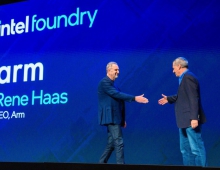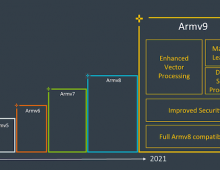
ARM and GLOBALFOUNDRIES To Work Together On 20nm And FinFET Process Technologies
GLOBALFOUNDRIES and ARM today announced a multi-year agreement to jointly deliver optimized system-on-chip (SoC) solutions for ARM processor designs on GLOBALFOUNDRIES' 20-nanometer (nm) and FinFET process technologies.
The new agreement also extends the collaboration to include graphics processors, which are becoming an increasingly critical component in mobile devices. As part of the agreement, ARM will develop a full platform of ARM Artisan Physical IP, including standard cell libraries, memory compilers and POP IP solutions. The results are expected to help enable a new level of system performance and power-efficiency for a range of mobile applications, from smartphones to tablets to ultra-thin notebooks.
The companies have been collaborating for several years to jointly optimize ARM Cortex-A series processors, including multiple demonstrations of performance and power-efficiency benefits on 28nm as well as a 20nm test-chip implementation currently running through GLOBALFOUNDRIES fab in Malta, N.Y. This agreement extends the prior efforts by driving production IP platforms that will enable designs on 20nm and promote migration to three-dimensional FinFET transistor technology.
GLOBALFOUNDRIES plans to develop optimized implementations and benchmark analysis for next-generation ARM Cortex processor and ARM Mali graphics processor technologies. The platform of ARM Artisan Physical IP for GLOBALFOUNDRIES' 20nm-LPM and FinFET processes and POP IP products provide fundamental building blocks for SoC designers. This platform builds on the existing Artisan physical IP platforms for numerous GLOBALFOUNDRIES' process technologies including 65nm, 55nm, and 28nm, as well as the Cortex-A9 POP technology for 28nm SLP, now available for licensing from ARM.
"This early engagement promotes the rapid adoption of ARM and GLOBALFOUNDRIES technologies in future SoCs for several important markets," said Simon Segars, executive vice president and general manager, Processor and Physical IP Divisions at ARM. "Customers designing for mobile, tablet and computing applications will benefit extensively from the energy-efficient ARM processor and graphics processor included in this collaboration. By proactively working together to enable next-generation 20nm-LPM and FinFET process technologies, our mutual customers can be assured a range of implementation options that will enable two more generations of advanced semiconductor devices."
ARM POP technology accelerates the core hardening for ARM?s Cortex-A series CPUs with leading performance, power and area. POP IP products are comprised of three critical elements necessary to achieve an optimized ARM core implementation. First, it contains Artisan physical IP standard cell libraries and memory cache instances that are specifically tuned for a given ARM processor and foundry technology. Second, it includes a benchmarking report to document the exact conditions and results ARM achieved for the processor implementation across an envelope of configuration and design targets. Finally, it includes the detailed implementation knowledge including floor plans, scripts, design utilities and a POP Implementation Guide, which enables the company's end customers to achieve similar results with lower risk.
GLOBALFOUNDRIES claims that its 20nm-LPM technology platform delivers up to 40% performance improvement and twice the gate density of 28nm. Since it will offer a range of transistor capabilities, 20nm-LPM will serve a broad range of power and performance points across high-volume market segments.
This collaboration also extends to GLOBALFOUNDRIES' FinFET-based process technology. By anticipating this process technology from the beginning, the partners will jointly optimize both the physical IP and process technology to assure a rapid migration path from 20nm-LPM. As a result, this collaboration will result in a range of implementation solutions available sooner and at lower risk than ever before.
"ARM technologies are at the heart of many of the world?s highest volume product categories, and we believe will only grow in importance for our customers in the years ahead," said Mike Noonen, executive vice president, worldwide marketing and sales at GLOBALFOUNDRIES. "By leveraging our implementation knowledge and applying it to a next-generation, energy-efficient ARM processor and graphics processing unit, we believe we can jointly offer a compelling differentiation to our mutual customers that will power innovation into the next two generations."
The companies have been collaborating for several years to jointly optimize ARM Cortex-A series processors, including multiple demonstrations of performance and power-efficiency benefits on 28nm as well as a 20nm test-chip implementation currently running through GLOBALFOUNDRIES fab in Malta, N.Y. This agreement extends the prior efforts by driving production IP platforms that will enable designs on 20nm and promote migration to three-dimensional FinFET transistor technology.
GLOBALFOUNDRIES plans to develop optimized implementations and benchmark analysis for next-generation ARM Cortex processor and ARM Mali graphics processor technologies. The platform of ARM Artisan Physical IP for GLOBALFOUNDRIES' 20nm-LPM and FinFET processes and POP IP products provide fundamental building blocks for SoC designers. This platform builds on the existing Artisan physical IP platforms for numerous GLOBALFOUNDRIES' process technologies including 65nm, 55nm, and 28nm, as well as the Cortex-A9 POP technology for 28nm SLP, now available for licensing from ARM.
"This early engagement promotes the rapid adoption of ARM and GLOBALFOUNDRIES technologies in future SoCs for several important markets," said Simon Segars, executive vice president and general manager, Processor and Physical IP Divisions at ARM. "Customers designing for mobile, tablet and computing applications will benefit extensively from the energy-efficient ARM processor and graphics processor included in this collaboration. By proactively working together to enable next-generation 20nm-LPM and FinFET process technologies, our mutual customers can be assured a range of implementation options that will enable two more generations of advanced semiconductor devices."
ARM POP technology accelerates the core hardening for ARM?s Cortex-A series CPUs with leading performance, power and area. POP IP products are comprised of three critical elements necessary to achieve an optimized ARM core implementation. First, it contains Artisan physical IP standard cell libraries and memory cache instances that are specifically tuned for a given ARM processor and foundry technology. Second, it includes a benchmarking report to document the exact conditions and results ARM achieved for the processor implementation across an envelope of configuration and design targets. Finally, it includes the detailed implementation knowledge including floor plans, scripts, design utilities and a POP Implementation Guide, which enables the company's end customers to achieve similar results with lower risk.
GLOBALFOUNDRIES claims that its 20nm-LPM technology platform delivers up to 40% performance improvement and twice the gate density of 28nm. Since it will offer a range of transistor capabilities, 20nm-LPM will serve a broad range of power and performance points across high-volume market segments.
This collaboration also extends to GLOBALFOUNDRIES' FinFET-based process technology. By anticipating this process technology from the beginning, the partners will jointly optimize both the physical IP and process technology to assure a rapid migration path from 20nm-LPM. As a result, this collaboration will result in a range of implementation solutions available sooner and at lower risk than ever before.
"ARM technologies are at the heart of many of the world?s highest volume product categories, and we believe will only grow in importance for our customers in the years ahead," said Mike Noonen, executive vice president, worldwide marketing and sales at GLOBALFOUNDRIES. "By leveraging our implementation knowledge and applying it to a next-generation, energy-efficient ARM processor and graphics processing unit, we believe we can jointly offer a compelling differentiation to our mutual customers that will power innovation into the next two generations."





















